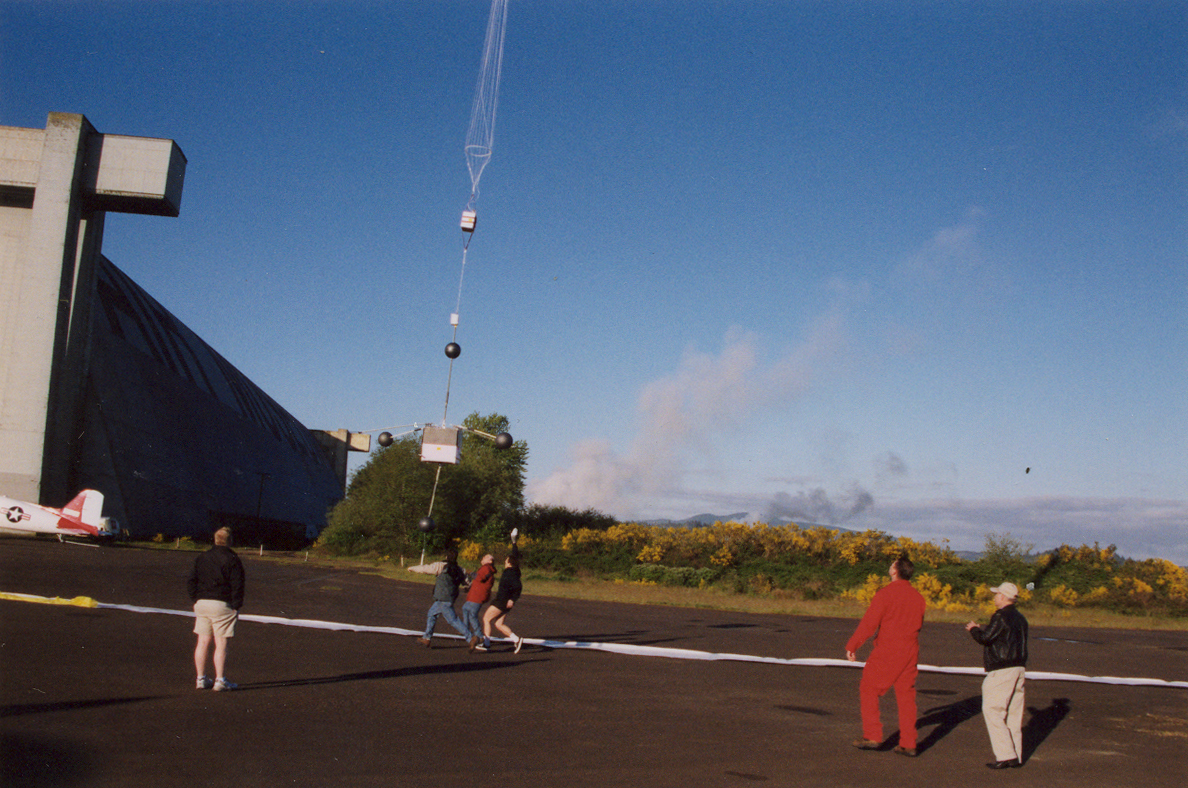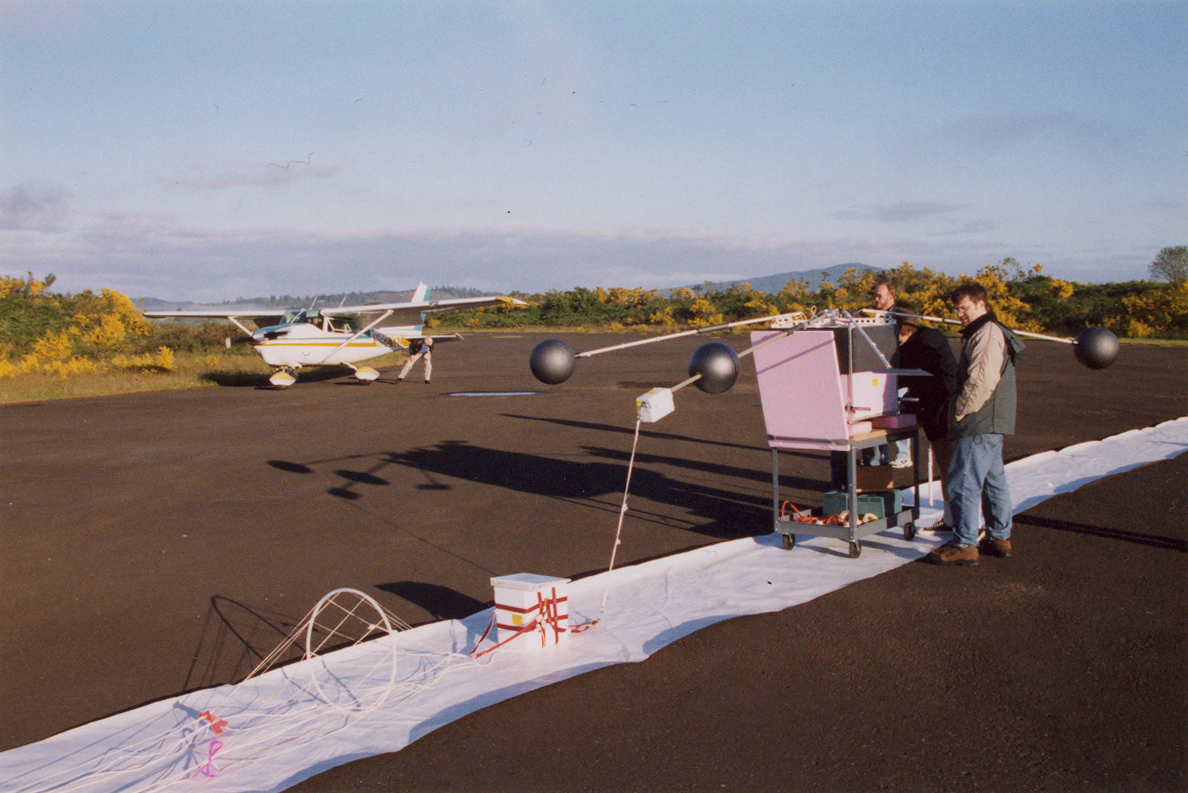Home | Sprites | The Experiment | Photos | Team

Sprite Test Flight Launch From Tillamook, OR May 15, 2002

Sprite Test Flight Launch From Tillamook, OR May 15, 2002
Quick Overview of the Experiment:
In November and December of 2002 3-4
balloon payloads will be launched from Southeastern Brazil to an altitude
of 32-38km to measure electric and magnetic fields, along with x-rays and
optical lightning associated with sprites. This is a joint collaboration
between the University of Washington, INPE in Brazil, and Utah State University
supported by a grant from the NSF.
The Sprite Payload
The Basics:
-18in x 18in x 18in aluminum frame with 2in of foam insulation
-total weight of ~70lbs
-6 booms allow for vector electric and magnetic field measurements
-designed to be launched by hand
-data sent by radio signal to ground station
Working on the test flight payload inside the Tillamook Blimp Hangar, May 2002
A List of the Instruments
-Low voltage (LV) electric field probes on all three axes
for a vector E-field measurement
-High voltage (HV) electric field probes on two axes,
one horizontal and one vertical
-Magnetic search coils on all three axes for a vector
B-field measurement
-Two x-ray detectors, one pointing up and one pointing
down
-Two optical lightning detectors, one pointing up and
one pointing down.
-Optical video camera to be flown on an airplane
Low Voltage Electric Field Probes
-12in. diameter spheres placed on six booms to give voltage
difference measurements along all three independent directions
-Probe sensitivity is about 0.001V/m with a range of up to about
10V/m
-Divide by the sphere separation to get E-field along each direction.
Hence we have a vector E-field measurement
-Spheres are coated with Aquadag (a carbon paint) for an uniform
work function. The work function is important since the photo-electric
effect produces voltages on the spheres.
-The payload is rotated at 2 revolutions per minute to eliminate
dc offsets in the horizontal probes due to work function differences or
other effects that are constant over the period of rotation.
The High Voltage Electric Field Probes
-8in. long by 1.5in. diameter cylinders placed on four booms
to give voltage difference measurements along two independent directions,
one vertical and one horizontal
-Probe sensitivity is about 0.1 V/m for a range of up
to about 1kV/m
-This is the only new instrument to be flown. Since we
expect large E-fields in the vicinity of sprites, these HV probes are crucial.
We hope to be the first group to get a true in situ (within 50km) measurement
of a E-field associated with a sprite.
-The magnitude of the E-field in this near field region will
tell us if either the quasi-electrostatic field or runaway electron model
for sprites is more valid.

Jeremy and Mike with the Sprite Test Flight Payload Just Prior to Launch
The Magnetic Search Coils
-Magnetic search coils on all three axes for vector B-field
measurement
-Sensitivity of 0.5pT with a range from 0.5pT to about 2.5nT
-The magnetic field data gives us the direction and magnitude
of the current associated with sprites which is important to sprite models.
The X-Ray Detectors
-Two x-ray detectors, one pointing upward and one downward
-Sodium iodine (NaI) scintillator viewed by photo-multiplier
tubes (PMTs)
-Measures x-ray spectrum above about 30keV
-Important measurement in determining the sprite mechanism.
The runaway electron model includes the production of x-rays from accelerated
electrons.
-X-rays also may be produced in the sprite channel
The Optical Lightning Detectors
-Two optical lightning detectors: One pointing upward
to see sprites and one downward to see lightning
-They use a photo-diode to measure light
-A shield must be placed above the upward pointing detector
to block balloon reflected light from lightning
-Tells us when the lightning (depending a cloud blockage) and
sprites occur, but not where they occur
Optical Video Camera
-Not part of the balloon payload, will be flown on an airplane
-Will confirm the presence of sprites and possibly blue jets
-Developed by Michael Taylor at Utah State University
Telemetry
-All data is sent back to the ground station to be stored, nothing
is saved onboard
-We use the amateur band 915MHz to transmit with a 3Mbps telemetry
rate
-Up to a 20kHz sampling rate per channel
-The 4.5 hr test flight acquired 6GB of data
Bob and Mike tracking the balloon shortly after the test flight launch.
The Test Flight
On May 15, 2002 the Sprite Test Flight was conducted at Tillamook,
OR with the help of GSSL, Inc. The flight lasted 4 hours 13 minutes
and successfully tested the telemetry and instruments. The main goals
of the test flight were to test the telemetry and the HV E-field Detector.
The telemetry worked well and is being perfected this summer. The
HV probes worked, measuring the low E-field as expected with fair weather.
The true test will come in Brazil when we hope to measure strong E-fields
(100s of V/m) above large thunderclouds.
Going to Brazil to Measure Sprite Properties
Why Brazil?
The Brazilian Space Agency (INPE) is providing all of the in-the-field
support, including the airplane for the video camera and the cut-down mechanism
for the balloon. Sprites have been observed above the intense thunderstorms
that occur in Southeastern Brazil during Oct-Nov. The window for our launch
is from mid Nov. to mid Dec. 2002. Three to four balloon payloads
will be launched from Cachoeira Paulista, approximately 200km northeast
of Sao Paulo. Launches will occur around sunset with flights lasting
from 10-12 hours throughout the night. The float altitude is about
32-38km.

In Conclusion: What we hope to achieve and how
this ties into sprite models
-We hope to get within 50km of a sprite event to see the E-field,
B-field, and x-ray signature of sprites in this near field region.
-These in situ sprite measurements have never been successfully
accomplished. In 1999 E.A. Bering’s group at the University
of Houston came within 400km (the radiation field region) of a sprite with
their balloon payload.
-Bering’s group measured a 275 mV/m vertical E-field during
the sprite burst(Bering et al., 2002), within 50km of the sprite we expect
to measure (with the new HV probes) a vertical E-field a few hundred times
larger.
-The magnitude of the vertical E-field will tell us if the quasi-electrostatic
field or runaway electron model is more valid
-The detection of x-rays will support the runaway electron model,
since the cosmic ray secondary particles produce them through bremsstrahlung
-The in situ (within 50km) E-field pulse will allow us to characterize
sprites in the near field rather than the radiation field
-The B-field pulse will tell us the horizontal and vertical
current density associated with sprites in the near field
-Thus our experiment will validate one the sprite models outlined
or lead to new model
Jeremy Thomas Oct. 10, 2002